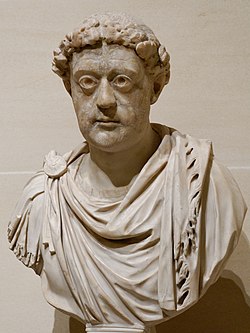
Back Leo I van Bisantium Afrikaans Leo I. (Byzanz) ALS León I de Bizancio AN ليو الأول Arabic ليو الاول ARZ بیرینجی لئون (بیزانس) AZB Леў I Макела Byelorussian Лъв I Тракиец Bulgarian Leon Iañ (impalaer) Breton Lleó I el Traci Catalan
| Leo I | |||||
|---|---|---|---|---|---|
 | |||||
| Roman emperor | |||||
| Reign | 7 February 457 – 18 January 474 | ||||
| Coronation | 7 February 457 | ||||
| Predecessor | Marcian | ||||
| Successor | Leo II | ||||
| Western emperors |
| ||||
| Born | c. 401 Thracia or Dacia Aureliana, Eastern Roman Empire | ||||
| Died | 18 January 474 (aged 73)[3] Constantinople | ||||
| Spouse | Verina | ||||
| Issue | Ariadne, Leontia, unnamed son | ||||
| |||||
| Dynasty | Leonid | ||||
| Religion | Chalcedonian Christianity | ||||
Leo the Great | |
|---|---|
 16th cent. Russian icon depicting St. Leo's enshrinement of the Robe of the Theotokos in Sts. Peter and Mark church, Blachernae | |
| Holy and Right-Believing Emperor of the Romans | |
| Venerated in | Eastern Orthodoxy |
| Feast | 20 January |
| Attributes | Imperial attire |
Leo I (Ancient Greek: Λέων, romanized: Leōn; c. 401 – 18 January 474), also known as "the Thracian" (Latin: Thrax; Ancient Greek: ὁ Θρᾷξ),[c] was Eastern Roman emperor from 457 to 474. He was a native of Dacia Aureliana near historic Thrace. He is sometimes surnamed with the epithet "the Great" (Latin: Magnus; Ancient Greek: ὁ Μέγας), probably to distinguish him from his young grandson and co-augustus Leo II (Ancient Greek: ὁ Μικρός, romanized: ho Mikrós, lit. 'the Small').[d]
During his 17-year rule, he oversaw a number of ambitious political and military plans, aimed mostly at aiding the faltering Western Roman Empire and recovering its former territories. He is notable for being the first Eastern Emperor to legislate in Koine Greek rather than Late Latin.[10] He is commemorated as a saint in the Eastern Orthodox Church, with his feast day on 20 January.[11][12]
- ^ "Statue – Louvre Collections. Léon (?". Louvre Collections (in French). Retrieved 6 February 2024.
- ^ Alabaster head with corona civica, on modern bust. Unknown provenance. Late fifth century, LSA-593. Last Statues of Antiquity
- ^ a b c PLRE 2 p. 664
- ^ Rösch 1978, pp. 165.
- ^ Adkins, Lesley; Adkins, Roy A. (1994). Handbook to Life in Ancient Rome. New York: Infobase Publishing. p. 37. ISBN 9780816074822.
- ^ Crawford, Peter (2019). Roman Emperor Zeno. Pen and Sword History. p. 45. ISBN 9781473859272.
- ^ Campbell, Brian; Tritle, Lawrence A., eds. (July 2017). The Oxford Handbook of Warfare in the Classical World. Oxford University Press. p. 26. ISBN 9780190499136.
- ^ a b Oxford Dictionary of Byzantium, pp. 1206–1207
- ^ "Leo I". Encyclopædia Britannica
- ^ Chris Wickham (2009). The Inheritance of Rome. Penguin. ISBN 978-0-670-02098-0. p. 90.
- ^ "Ὁ Ἅγιος Λέων Μακέλλης ὁ Μέγας" [Saint Leo Makelles the Great] (in Greek). Μεγασ Συναξαριστης [Great Synaxaristes].
- ^ Mother of God of the "Life-Giving Spring". Self-Ruled Antiochian Orthodox Christian Archdiocese of North America. Retrieved 27 October 2012.
Cite error: There are <ref group=lower-alpha> tags or {{efn}} templates on this page, but the references will not show without a {{reflist|group=lower-alpha}} template or {{notelist}} template (see the help page).